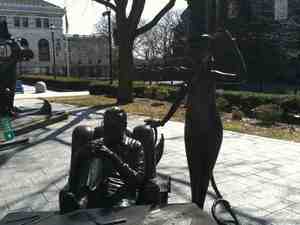The Cattle Towns is a social history of the Kansas cattle trading centers of Abilene, Ellsworth, Wichita, Dodge City and Caldwell of 1867 to 1885. The creation of each town was facilitated by the need of a local cattle market for Texas cattle. The Kansas Cattle Trading Center or “cattle town” of the 1870’s and 1880’s has up to now belonged more to the imagination than to history. The lively rendezvous of cowboy, cattleman, gambler and city marshal is currently a theatrical image only tenuously connected with tradition. Catering to a popular fascination with violence, the idea of the cattle town seems at every brow-level to be scarcely more than a gathering of taut characters with itchy trigger fingers. The first attempt to deal at any length with the major cattle towns as social units was Floyd Benjamin Streeter’s Prairie Trails and Cow Towns. This was more an academic book, long on violence and short on useful community details. There has been a more recent attempt but it was really no improvement, until now. In the 1880’s the term “cow town” was a derogatory term, not used by any self- respecting cattle town people themselves. As a historical reality, the cattle town has much more to offer. It was technically speaking, an interior market facility, situated at the juncture of railroad and Texas cattle trail where drovers sold their livestock to buyers. The collective experience of the five cattle towns examined here spans the entire period of the Texas cattle trade in post-Civil War Kansas-the years from 1867 through 1885.
The two most famous cattle towns were, Abilene, first of the principal cattle trading centers, and Dodge City, the longest lived. Of the remaining; Ellsworth, Wichita, and Caldwell, all enjoyed reputations as being among the most important range cattle markets in the West.
Abilene was already six years old when it was first discovered by the Texas cattle trade. Due to its placement as a route designated by the Kansas Pacific Railway and the Union Pacific railway, its lush surrounding green pastures, the abundance of water from Smoky Hill River and the vision of Joe McCoy, Abilene would soon be on the map as a major Texas cattle market.
McCoy came from a family of brothers known for the entrepreneurial spirit. In Springfield Illinois the brothers owned William K. McCoy and Brothers, a flourishing livestock firm. During Joe’s first year in business with his brothers he did business with one bank alone to the tune of $2.5 Million, he later admitted that the firms resources were finically unlimited. There was just one flaw to Joe’s plan for Abilene. The problem stemmed from the fact that Texas cattle were known to be carriers of the lethal splenic fever, commonly called “Spanish” or “Texas” fever to which the rugged longhorns were practically immune, but Northern herds were devastated by. All a longhorn had to do was to walk through a pasture of northern cattle and the cattle literally dropped dead, it was that lethal. Quarantine measures were put into effect that practically limited Texas cattlemen to no market at all to ship eastward. This is where the western Kansas towns came into the picture. During the winter months, the tiny tick that transmitted the splenic fever was dead. But during the summer and autumn months, the Texas cattlemen were forbidden entry into east Kansas and southwest Missouri, their only market sources. Something had to be done to open this market up for Texas cattle.
In a book published in 1874 by Joe McCoy, he credits no one but himself for conceiving the idea for opening up an outlet for Texan cattle. This was to be a market where the southern drover and the northern buyer would meet upon equal footing and both be undisturbed by mobs or swindling thieves. Circumstantial evidence suggests that a small group of wealthy and important enterprisers caused the inclusion of certain key provisions in the 1867 Act for the Protection of Stock from Disease that paved the way for McCoy’s project.
As the Union Pacific Railroad edged ever westward to Ellsworth County, the potential of more and newer towns were on the horizon. Ellsworth being one of them, but at the same time Kansans were moving either for or against repealing the 1861 statute that forbade the summertime driving of longhorns into the state. The vertical quarantine line determined by Congress limited the cattlemen substantially eastward to the west edge of Dickinson County. They added to the act of 1867 that longhorn railroad shipment through the state was allowed and that also an incorporated and bonded group could survey a trail from the quarantine zone to a cattle market on the Union Pacific tracks for shipment of the stock. This cattle market could not be east of a line running through Ellsworth County, this change obviously benefited the proposed town site of Ellsworth, and this also made shipping cattle from Abilene now illegal. But that did not matter to Joe McCoy. He had other thoughts on his mind, such as the 250 acres he was getting ready to purchase to build his world cattle class shipping facility. Soon he was to have potent competition from another town, just down the tracks.
Cattle drovers tended to repeat themselves in their yearly travels to the Kansas cattle towns. Tending toward a highly unstable business, the individual cattlemen preferred to return to a familiar trading center where experience with the town, its outlying ranges, its businessmen, and its railroad agents helped to settle any apprehension about prices and dealers. Even so, especially in the first half of the cattle trading era, all entrepreneur groups connected with the cattle trade remained mobile and capable of shifting to a new shipping point as conditions changed. This made for a very transient economy for the cattlemen, gamblers, prostitutes, and businessmen. They moved where the business was, and over time this would either make or break a town.
Town councils took to hiring gunslingers and local drifters as a hired police force when the cattlemen were held in town too long either because of shipping, or herd conditions. This made for ill feelings amongst the cattlemen, and the businessmen, who neither profited from, nor liked the treatment often passed onto them. Many fines were handed to lounging drovers accused of false crimes by the police, this caused many cattlemen to move their business to neighboring towns to avoid the harassment. The town, who survived off of the cattle business realized their mistake and fired many of the gunslingers before their economy was irreparably damaged.
As we have seen, each community triumphed over varying degrees of difficulty in becoming a full-fledged cattle trading center. Abilene, Ellsworth, and Dodge City sprang up beside the railroad line; the main concern of their citizens was to attract cattlemen to already available shipping facilities. Wichita and Caldwell had been purposely fixed on the established cattle trail; the problem here was attracting railroads. Yet, once having gained the proper joining of railroad track and cattle trail, townsfolk discovered that the struggle had only begun. Preserving the community’s cattle trade, they found, was to be an annual effort requiring the expenditure of considerable sums of energy, influence and money, and these were things that most of the towns were short on.
In the 1950’s the citizens of Abilene, Wichita, and Dodge City capitalized on the emergence of “adult western” movie and television dramas and put together collections of frontier structures to reproduce the cattle town of the past for the tourist trade. This is what our cattle town history has been reduced to. Many of the westerns we view today were either made in or about one of the Kansas cattle towns with no realistic image of the real past. This was a difficult existence, and the author has provided us with a very in-depth examination of the times and circumstances. You can actually place yourself on the bench outside the dry good’s store with the drovers as they passed the time, whittling, smoking or napping. They were patiently waiting until sundown, or until the next set of railcars came through. Their hope was that maybe this time the price for their cattle would be better.
Robert Dykstra is a spinner of tales, facts, legends, and history, the book is not short on information about any of the towns either. There is almost too much information to condense into a five page paper. I found the information interesting, to say the least, but then, I grew up in Missouri and lived in Kansas for three years, so much of the history I was already aware of. I was pleasantly surprised to learn about the “Dodge City War”, something I did not know. It had all the intrigue of Prostitution, gunslingers, vigilantes, and the state militia, not such a boring book at all. This is the “good stuff” of history.
Dykstra, Robert R., The Cattle Towns. (New York: Antheum, 1979).





